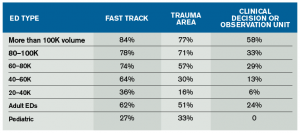
Explore This Issue
ACEP Now: Vol 33 – No 08 – August 2014Table 2. EDBA Data Survey 2013—Operating Areas of U.S. EDs
There are important decisions that must be made about the design of functional areas within or around the ED. Many EDs have patient volumes and needs that justify the development of fast-track areas for low-acuity patients, trauma-receiving areas, mental health suites for safe management of those patients, and clinical decision or observation units. Most EDs that see more than 40,000 patients per year have one or more of these functional areas. Smaller-volume EDs typically don’t have the need for designated service areas. Functional areas are reported in Table 2.
Emergency physicians and ED leaders must able to use and understand the elements of ED design that provide an environment for high-quality emergency care and have comparison data available for their peers. This will accommodate higher patient volumes, acuity, and management of patients through the diagnostic and treatment phase of their emergency care.
References
- Centers for Disease Control and Prevention. National Hospital Ambulatory Medical Care Survey: 2010 Emergency Department Summary Tables. CDC Web site. Available at: http://www.cdc.gov/nchs/data/ahcd/nhamcs_emergency/2010_ed_web_tables.pdf. Accessed July 16, 2014.
- The Emergency Department Benchmarking Alliance. Available at: www.EDBenchmarking.org.
 James J. Augustine, MD, FACEP, is director of clinical operations at EMP in Canton, Ohio; clinical associate professor of Emergency Medicine at Wright State University in Dayton, Ohio; vice president of the Emergency Department Benchmarking Alliance; and on the ACEP Board of Directors.
James J. Augustine, MD, FACEP, is director of clinical operations at EMP in Canton, Ohio; clinical associate professor of Emergency Medicine at Wright State University in Dayton, Ohio; vice president of the Emergency Department Benchmarking Alliance; and on the ACEP Board of Directors.
Pages: 1 2 3 | Single Page






One Response to “Emergency Department Benchmarking Alliance Reports on Data Survey for Next-Generation ED Design”
October 12, 2015
How San Diego's Emergency Room Wait Times Stack Up[…] public and potential patients had access to it,” said Dr. James Augustine, vice president of the Emergency Department Benchmarking Alliance, a panel of ED care experts developing better measures to evaluate care provided by emergency room […]